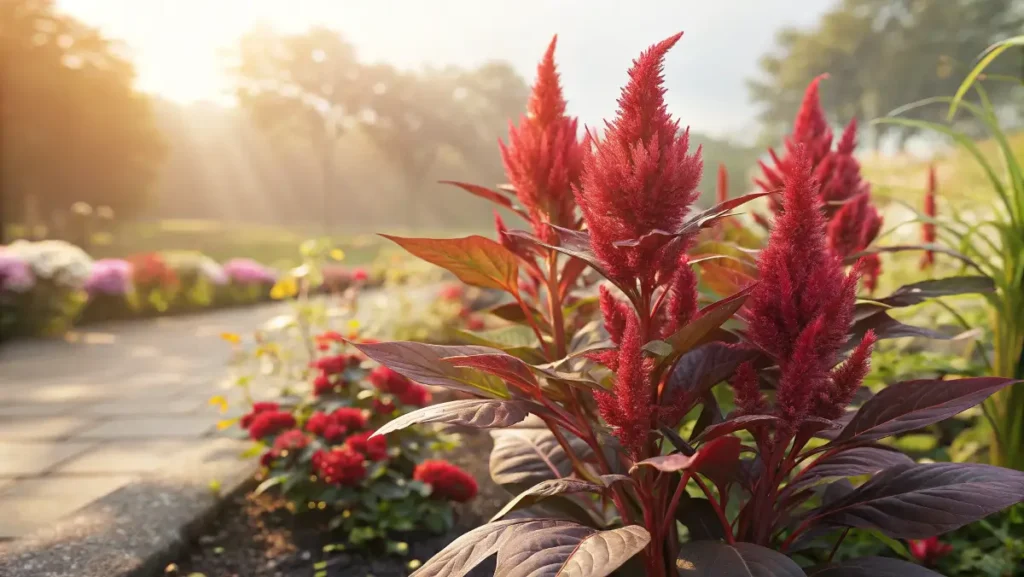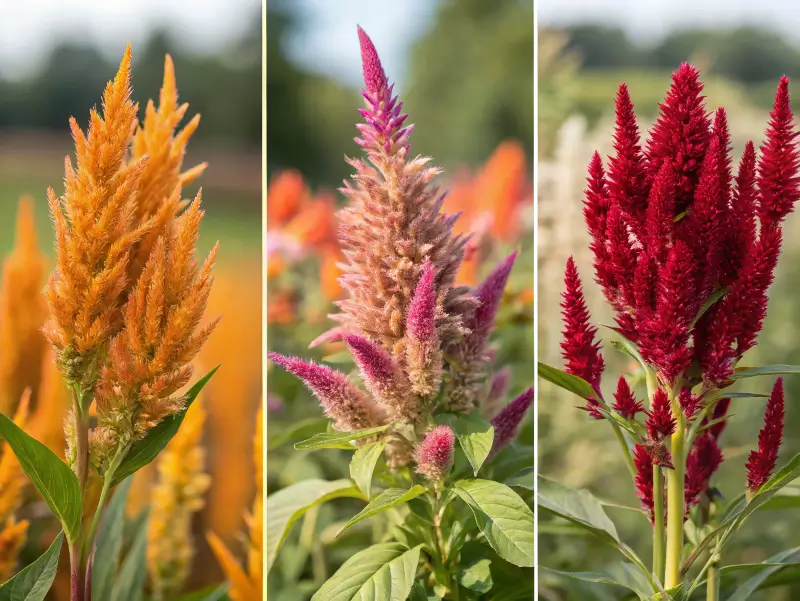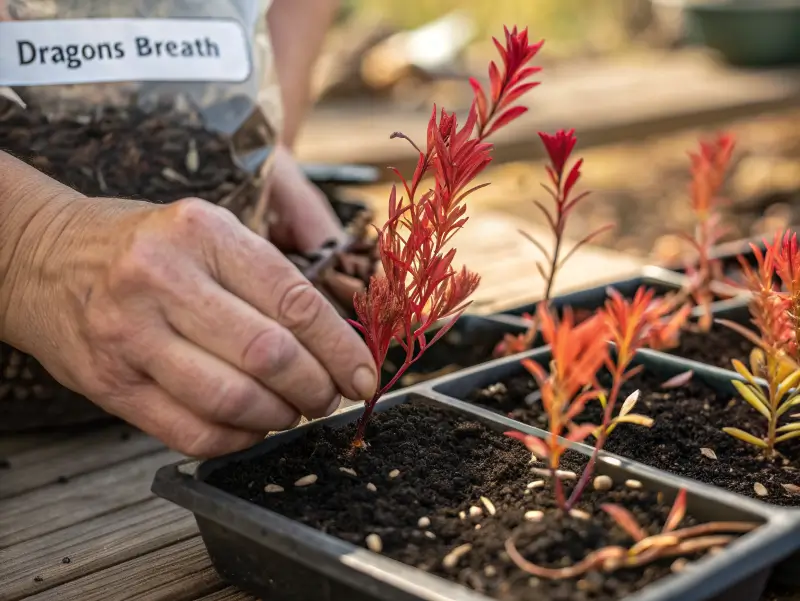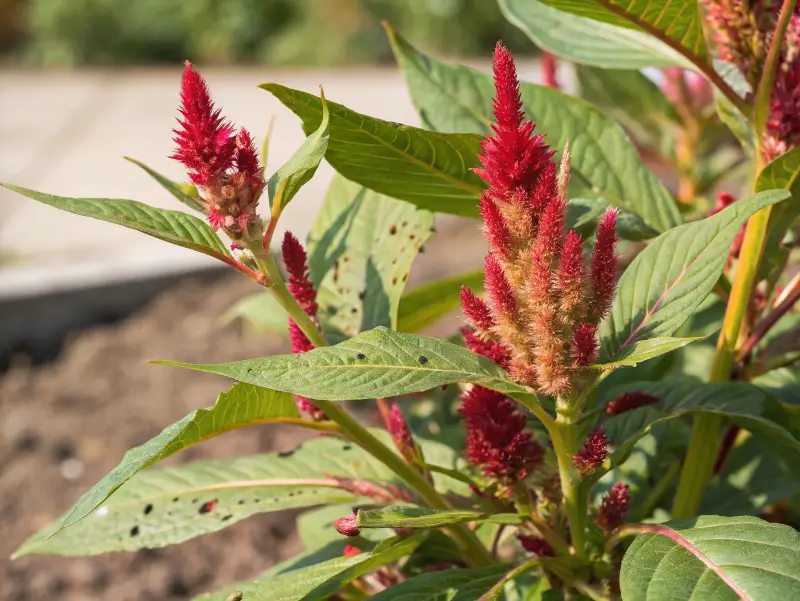
In this Article
The Dragons Breath Plant (Celosia argentea ‘Dragons Breath’) is an annual flower prized for its vibrant, fire-toned plumes and dramatic burgundy leaves. Dragons Breath Plant grows about a foot tall and blossoms in fuzzy, flame-like spires that glow in bright daylight. This beautiful plant likes consistent watering, though it hates soggy roots, and it absolutely basks in sunshine. It’s considered pet-safe, but it’s still wise to keep it out of reach if you have nibbling pets at home. Overall, you’ll find it enjoyable to grow and stunning to behold.
Dragons Breath Plant Care
Growing the Dragons Breath Plant is straightforward once you keep in mind the essentials of light, water, soil, temperature, and feeding. Honestly, once I got the hang of it, these striking plumes transformed my garden into a mini red-hot kingdom.
Light Requirements
Sunlight is vital here. The Dragons Breath Plant loves full sun, meaning six hours or more of direct light. If you happen to live where summers scorch, a bit of afternoon shade can keep foliage from looking fried. Indoors, a south-facing window is best. Rotate containers every so often so those bold plumes don’t tip in one direction—these plants can lean happily toward bright rays if left unturned.
Watering Needs
Regular watering keeps this flame-like wonder happy. However, you want the soil lightly moist, not marshy. If the top inch of your mix is dry, grab your watering can and soak the soil around the base. Yet, give the Dragons Breath Plant time to drain. Watch for signs of overwatering, like rot or constantly wet spots. If your climate is especially hot, you may need to water more often, but the trick is to feel the soil before you pour.
Soil Preferences
Good drainage is key to avoiding problems. A potting mix that drains quickly but holds some moisture suits the Dragons Breath Plant perfectly. Adding a bit of compost can help if your garden soil’s texture is lacking. Aim for pH levels near 6.0 to 7.0. If your ground is clay-heavy, consider raised beds or blend in coarse sand to boost drainage. Too much water around the roots spells trouble for these bold blooms.
Temperature and Humidity
This plant thrives in warm conditions, generally around 70°F or higher. If your region has toasty summer days, the Dragons Breath Plant will likely hit peak glory. Excess humidity isn’t a problem, though very dry air can crisp the leaf edges if you forget to water. If nights dip below 55°F, consider bringing the pot indoors (where it can still get sun) or covering it outside if you think you can stretch the season just a bit longer.
Fertilizer Requirements
Feeding the Dragons Breath Plant with a balanced, water-soluble fertilizer every couple of weeks during the growing season helps keep the blooms bright. Some folks go for organic flower-based fertilizers, which is great. Do keep an eye out for excessive nitrogen—too much encourages leafy growth but fewer plumes. If your plant looks overly lush without many flowers, scale back on fertilizer for a spell.
Types and Varieties of Dragons Breath Plant

When most people talk about the Dragons Breath Plant, they typically refer to Celosia argentea ‘Dragons Breath.’ However, there are other related Celosia types that rival these blazing red sensations.
Popular Cultivars
- ‘Dragons Breath Red’: Known for its intense red plumes and burgundy foliage. It’s the classic showstopper you’ll see in many garden shops.
- ‘Sunday Mix’: This mix can include pinkish or magenta blooms, offering a visual variety in one seed pack. It’s fun if you enjoy a range of fiery shades instead of a single color.
Related Celosia Varieties
- Cockscomb (Celosia cristata): This type has brain-like flower heads in bright shades of red, pink, or orange. Great for those who want a seriously attention-grabbing look.
- Wheat Celosia: Has upright, wheat-like spires and often comes in reds, pinks, and purples, offering a slightly subtler shape than the Dragons Breath Plant.
Selecting the Right Variety
Each cultivar has its own flair. If you prefer your garden to be loud and bold, the Dragons Breath Plant in vivid red is perfect. If you like moody or mysterious hues, check out the Black Dragon Plant guide for an equally dramatic look that pairs well with bright Celosia. Either way, it’s all about deciding how these fiery blooms will fit in with your overall design.
Pruning
I totally get why pruning can sound intimidating, but in truth, it’s a pretty chill process here. A little attention to pruning can help prolong the showy aspect of your Dragons Breath Plant.
When to Prune
Deadheading is your main task. Once those brilliant plumes start browning or look a bit dull, snip them at the base of the stem near a healthy leaf node. Doing this off and on encourages your Dragons Breath Plant to produce fresh blooms. At the season’s end, you can trim away worn stems, though as an annual, it’ll finish up its life cycle sooner or later.
Pruning Techniques
Use clean, sharp tools. I keep a designated pair of pruning shears at hand just for little tasks like this. Make a neat angled cut rather than crushing the stem. If you’re dealing with an unfortunate break from wind or a stray sports ball, trim off any ragged ends so your Dragons Breath Plant can look tidy again.
Maintenance Pruning
Beyond deadheading, just watch for yellow leaves, wilting stems, or damage. Removing these ensures your Dragons Breath Plant focuses energy on thriving foliage and vivid plumes. Since it’s an annual, regular winter pruning doesn’t really apply—once the season’s done, the plant is usually on its way out.
Propagating Dragons Breath Plant

Does your Dragons Breath Plant make you so happy you want more of it? You’re in luck because collecting seeds or starting seedlings is straightforward. It’s also a lovely DIY project to share with fellow gardening fanatics.
Seed Collection and Storage
After the flowers fade, you’ll notice seed heads on the plumes. Gently shake or tap them into a small container or paper envelope. Label it with the date so you don’t get confused later. Then store them in a cool, dry spot until you’re ready to sow next season. Avoid plastic or damp places or you’ll risk fungus, and that’s a bummer when you’re hoping to replant.
Starting from Seeds
Begin your seeds indoors 6-8 weeks ahead of the last frost date. A light covering of soil is enough—these seeds are tiny. Keep the tray or pots evenly moist and provide warmth, like on top of your fridge or with a heat mat. Germination typically appears in a couple of weeks. Once they’re sturdy enough and the weather’s reliably warm, situate them outdoors where they can bask in proper sunlight.
Alternative Propagation Methods
Though it’s possible to try cuttings, seeds are typically the easiest route for the Dragons Breath Plant. Plus, you’ll likely get plenty of seeds from just a couple of mature flowers. Division can happen if your plant creates side shoots, but that’s rare. In my opinion, collecting seeds is the most reliable method.
Potting and Repotting Dragons Breath Plant
I’ve had friends ask if they can grow the Dragons Breath Plant in containers. Definitely! A nice container allows you to pop this colorful gem on a balcony, patio, or front porch where the sunlight hits just right.
Container Selection
Pick containers with good drainage—clay or terracotta pots are a classic choice. Plastic pots hold moisture longer, so keep a closer eye on soil dampness if you go that route. Aim for a size wide enough to accommodate the roots plus some room to spread. If you want a spectacular arrangement, you can add other heat-loving annuals alongside your Dragons Breath Plant, assuming they share similar watering needs.
Potting Mix Preparation
A loose, airy mix that dries moderately fast but retains enough moisture keeps the Dragons Breath Plant comfy. Some folks like to blend a standard potting mix with compost and a bit of perlite or coarse sand. If in doubt, err on the side of drainage—again, these roots aren’t fans of sitting in water. For an equally eye-catching container combination, you could even pair it with the Black Dahlia Flower for a bold, dramatic contrast.
Repotting Process
Keep an eye on how quickly your Dragons Breath Plant grows. If you notice roots poking out the drainage holes or your plant stops putting on new growth, it might be pot-bound. Gently tip the pot to remove the plant, loosen the bottom roots a bit, and rehome it in a container just one size larger. Pack potting mix around the sides and water well. A mild, balanced fertilizer at repotting time can help it bounce back quickly.
Common Pests and Diseases

Even though it’s a tough-looking plant, pests will be pests. Sometimes you’ll see a few uninvited guests settling on your Dragons Breath Plant.
Frequent Pest Problems
- Aphids: Small, pear-shaped insects on the undersides of leaves or buds. A quick shower with mild soapy water can knock them down.
- Spider Mites: Hard to see, but you’ll notice mottled leaves or slight webbing. Consider a neem oil spray if rinsing doesn’t curb them.
- Whiteflies: Tiny white insects that flutter upward if you disturb the foliage. Sticky traps or insecticidal soap helps reduce numbers.
Disease Prevention
Fungal infections like powdery mildew appear as a white coating. Also, waterlogged soil can lead to root rot, where you’ll see the plant droop for no good reason. Check your watering routine, spacing, and avoid overhead irrigation if you spot trouble. A resource like the NC State Extension’s Celosia page offers more detailed info on potential plant diseases and how to manage them.
Integrated Pest Management
Try removing small infestations by hand or with water sprays first. Introduce beneficial insects if problems persist—it’s an easy way to address pests while keeping your garden pollinator-friendly. Also, tidying up plant debris around your Dragons Breath Plant helps by removing places pests or spores might lurk.
Common Issues with Dragons Breath Plant
We’ve all had those moments where our brilliant Dragons Breath Plant looks a little off. Don’t panic! Most hiccups have simple fixes that bring back the fiery flair you love.
Foliage Problems
- Yellowing Leaves: May be a sign of overwatering or soggy soil. Reassess your watering habits. If leaves stay wet for too long, back off the watering can.
- Brown Leaf Tips: Usually linked to dryness or uneven moisture. If the climate’s super dry, occasional misting around (not on) leaves can help, or you can water a tad more often.
- Wilting Plant: Check the soil. Too little or too much water can produce similar symptoms. Usually, feeling the top inch of soil tells you what to do next.
Blooming Issues
- Poor Flower Production: If your Dragons Breath Plant is healthy in foliage but missing its famous plumes, it might not be getting enough sunlight. Or too much fertilizer might be pushing leaf growth instead of blooms. Cut back on fertilizer and shift it to a sunnier spot.
- Color Fading: Intense heat or just natural aging can dull those red tones. Providing afternoon shade can help in scorching temps, though it’s normal for colors to soften as flowers mature.
- Premature Bloom Drop: Can happen when the plant is stressed by extreme temperature swings or watering mishaps. Keeping conditions stable usually helps solve this.
Growth Concerns
- Stunted Growth: Possibly soil that’s too poor or not enough water. Feed with a balanced fertilizer at half-strength if you suspect nutrient deficiency.
- Leggy Plant: When stems are long and spindly, the Dragons Breath Plant probably needs more sunlight. Shift it somewhere brighter and consider pinching back tips to encourage bushier growth.
- Environmental Stress: Cold snaps or record heat waves can stress your Dragons Breath Plant. Temporary covers or partial shade during the hottest hours might provide relief.
FAQ
Do dragon breath plants come back every year?
No, the Dragons Breath Plant is an annual, so you won’t see it return by itself next spring. You can gather seeds and start again, though!
Is dragons breath a perennial or annual?
It’s definitely annual. Despite looking fierce, it won’t survive winter frost in most climates.
Where is the best place to plant dragon’s breath?
Anywhere sun-drenched with well-draining soil is perfect. Beds, borders, and containers all work as long as you maintain consistent watering.
Is dragon’s breath an indoor or outdoor plant?
The Dragons Breath Plant can be grown both ways. Outdoors is typically preferred because of direct sunlight, but if you have a bright window, you can keep it going indoors.
When you discover how easygoing the Dragons Breath Plant can be, it’s tough not to fill every sunny spot with its flashy blooms. Whether you’re starting from seed, potting them up in containers, or adding them to a blazing red garden combo, these plumes deliver seriously fiery vibes all season long. Just remember to water thoughtfully, trim off spent blooms, and bask in the admiration of passersby who can’t help but stop for a closer look. Enjoy the burst of color, and happy gardening!
